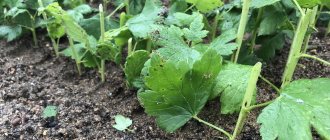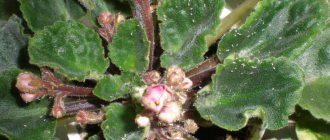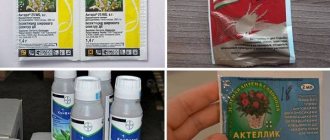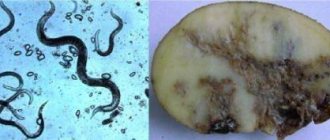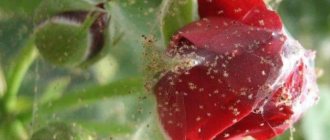Violets are common among gardeners due to their high decorative value. Many varieties not only have beautiful flowers, but also boast variegated foliage.
When Saintpaulias lose their decorative appearance, you need to think about why this happened. First of all, it is necessary to exclude mite infestation of the violet.
Ticks are divided into 3 categories:
- soft-bodied - a small transparent tick, elliptical in shape, reaching a length of 0.2 to 0.3 mm. Prefers to settle at plant growth points;
- armored - has more than 6,000 representatives; in home collections there are round, shiny black mites that live in the substrate. Harm occurs when the insect colony reaches a very large size;
- cobwebby and flat – has a red or green color, an oval shape ranging in size from 0.3 to 0.5 mm. Weaves a thin web in which he lives. It reproduces very quickly: 10-20 days pass from the beginning of egg laying to the adult individual. The total lifespan is 4-5 weeks.
Spider mite (close-up photo).
Flat beetle mite (photo under a microscope).
Transparent, cyclamen or strawberry mites love to eat Saintpaulias
Cyclamen mite (photo of an infected violet).
Next, we will show photos of signs of infection and tell you how to deal with spider mites and other categories of these pests.
Attention! Due to their tiny size, it is impossible to notice mites on the plant with the naked eye. The collector can only observe the consequences of their distribution.
Ticks - what kind of “living creatures” are they?
There are many varieties of ticks. But it is Saintpaulia that is often affected by three types of herbivorous parasites:
- strawberry mite,
- transparent greenhouse,
- cyclamen.
By and large, there is no need to find out exactly what type of mite has infected your violet, since this can only be found out through careful examination under a magnifying glass. In any case, most acaricides (chemical anti-mite drugs) act on many varieties of these pests.
But you still need to know something about ticks:
- These are not insects, but arthropods. Products designed to kill insects may not work on them.
- Often, several types of mites appear on a flower at once.
- Organisms can develop resistance to poisons, so medications must be constantly changed.
- Ticks are very tenacious, it is better not to waste time on various folk remedies that may not work, but to immediately treat the flowers with chemicals.
- If the plant has been attacked by pests once, it is recommended that after treatment it is treated for prevention once every 2-3 months, since mites can go into long hibernation.
Description and appearance
Most often, the cyclamen mite appears on violets, which also affects other indoor plants. Azaleas, Kalanchoes, and cyclamen are at greatest risk of infection. But these pests harm not only indoor flowers, they also affect garden and vegetable crops. They have very small body sizes and it is simply impossible to see them on a flower without magnifying devices. They belong to the arachnids.
They have a translucent, oblong body, light yellow in color, and 8 legs. They live in buds and on young shoots. Their diet consists of plant sap. These pests multiply very quickly and within a few days after infection the colonies increase significantly.
One female lays 12 to 16 eggs daily, which require only 3-7 days to develop. A week after laying eggs, young individuals appear, which need nutrition and are ready for further reproduction. You can see what they look like in the photo.
Favorable conditions that contribute to their rapid reproduction are warmth and minimal humidity. Therefore, the peak of their activity for indoor plants occurs in winter, when apartments have heating. And for garden crops, such a favorable environment occurs in the summer, when hot and dry days arrive.
Causes of infection
Violets are delicate plants that require proper care. The slightest violation of agricultural conditions will lead to an invasion of parasites.
Conditions that are comfortable for ticks are unfavorable for Saintpaulias:
- ambient temperature above +250C (optimal for violets 18-240C);
- insufficient lighting (plants need 13-14 hours of daylight);
- low humidity (violets develop organically in residential premises);
- excess nitrogen fertilizers (Saintpaulias require moderate feeding).
The condition of the soil also matters. The denser the soil, the greater the risk of mites infesting the flower pot.
Signs of defeat
Since it is impossible to see the pest on a violet, infection can be determined from the external signs that appear on the flower. Something similar to a dusty coating appears on young shoots, buds, as well as young green leaves. The mite infestation is most noticeable on the leaves, as they change color, become dull, a yellow tint appears, then they turn brownish-gray and the leaves become deformed.
The petioles and leaves become very dry and brittle. Also, thin hairs similar to cobwebs appear on young leaves. The buds do not open and begin to fall off.
If such signs are detected, it is necessary to relocate the infected flower so that the pests do not attack neighboring flowers. You will need to immediately resort to treatment methods.
Woodlice
While ticks breed when it's too hot, woodlice love dampness. Probably everyone has seen these creatures; they are very small crustacean insects. Woodlice that appear on violets are most often white in color. They pose a great threat to young violets.
Woodlice appear in damp and loose soil, damaging the leaves and root system of violets. Don’t be surprised if you see woodlice in your area; they could have gotten to you from a damp basement. If you live in a house, then you have probably seen them yourself quite often. You can get rid of woodlice in the same way as you can get rid of ticks; treat the violet with an acaricide according to the instructions.
Symptoms of mites on violets
The difficulty is that it can be difficult to understand why a violet is sick. These parasites are invisible, and their presence is indicated only by painful signs that can be confused with other causes.
And yet, we will try to highlight the main symptoms that are more characteristic of a tick-borne scourge:
- Saintpaulia leaves droop and the plant looks drooping.
- The petioles become brittle and sometimes fall off when touched.
- White, yellow, and brown spots may appear on the leaves.
- The edges of the leaves darken and curl.
- The plant does not bloom, and if there are buds, it does not bloom, quickly withering.
- The color of the leaves changes, becomes dull, and a coating appears on top.
- When you feel the leaves, you can feel the tubercles (deposited mite larvae).
- Flower growth slows down.
Note: mites love moisture, so they often nest in the rosette part of the violet closer to the soil. But if the plants live in greenhouses with high air humidity, then the parasites will be comfortable on any part of the violets.
Podura (springtails)
Sometimes, on the surface of a damp substrate in a pot with a violet, springtails or podura settle. When the owner sees this insect for the first time, he literally freezes with horror - after all, tiny white or cream-colored insects with antennae are crawling in the pot under the flower. There are specimens painted in a greenish or silvery tint. The average size of a podura is approximately 2 mm, but there are also large specimens, up to 1 cm in length. Some of them crawl, others also jump with the help of a special fork attached to the underside of the abdomen. By the way, this feature (jumping) distinguishes springtails from the larvae of other insects - mealybugs, fungus gnats and thrips.
In fact, poduras in small quantities are not dangerous for indoor plants, including violets. They are part of the natural soil fauna. Poduras settle on the surface of the ground, love dampness and readily reproduce in it. Poduras feed on plant particles that begin to rot. We recommend immediately reducing watering the plant. Indeed, during overflow, when water stagnates on the surface of the substrate, forming silt, “uninvited guests” form a mass population and become a problem for both the flower and its owner. Particularly large specimens of springtails can damage young Saintpaulia seedlings, and at low room temperatures, minor damage can cause various infections.
This may be interesting: All about caring for Eucharis or Amazon Lily
To remove the fungus, you should sharply reduce watering of the plant. Pay attention to the composition of the substrate - it should not contain components that cause the development of fungi and mold: sawdust, tea leaves, dry leaves. Deprived of their usual comfortable habitat, springtails will disappear on their own and will stop bothering your violets.
Another folk method against fools. Place the pot with the flower in a basin and fill it with settled warm water “over the top”. When the springtails float to the surface of the water, you will collect them with something like a strainer.
Regular raw potatoes, cut in half, will help to collect springtails. Place both halves cut side down on the surface of the substrate for several hours. All the springtails will gather on the potato cuts. All you have to do is carefully lift the halves from the ground, holding them with a flat spatula from below, in order to collect all the individuals and destroy them. This procedure will have to be carried out several more times until you are sure that you have gotten rid of all the individuals.
If the colony of springtails has become too numerous, we recommend treating the plant with insecticides. The drug Bazudin is suitable. It is scattered over the surface of the substrate in a thin layer. The fools will probably die within a few hours. The drug Pochin will cause a similar effect. Only its granules should be mixed with the soil. It will begin to act immediately, and in a few hours all insects will be destroyed. You can also treat the soil with a solution of Mospilan, Aktara, Pyrethrum according to the instructions. But the main thing is to dry the soil optimally.
Detection and control measures
Among the most dangerous mites, the one that primarily attacks indoor plants is the cyclamen mite (Phytonemus pallidus). Its dimensions are measured in microns, so the parasite can only be seen under a microscope.
However, the mite affects not only cyclamens; it can seriously harm Saintpaulia, Gloxinia, Kalanchoe, balsams and other indoor plants. As a rule, larvae and adults settle at the growth point, while young leaves become deformed, wrinkled and covered with gray or brown fluff. Flowers do not bloom, buds fall off.
The cyclamen mite develops very quickly in warm conditions and high humidity. Severely affected plants appear as if covered in dust.
Ticks reproduce extremely quickly. The young generation can be formed every three weeks, and under suitable conditions even after two. Therefore, if infection is suspected, the affected plants should be separated and fenced off.
Detection of cyclamen mite
The presence of an uninvited guest can be judged only by indirect external signs. In Saintpaulia, the main thing to pay close attention to is the deformation of flowers, which take on an unusual shape, often do not open at all, fly around at the bud stage, and have an abnormal color. The shoot is deformed, fresh leaves are affected, and they curl in every possible way. Long hairs on young leaves are clearly visible.
In other plants, these mites also often provoke deformation and depigmentation of damaged plant organs. They lead to drying out and deformation of the shoots, and changes in the shape of the leaves. Flowers may develop spots and may not bloom. These pests love high humidity, so they usually settle in the folds of young leaves, in the buds, where there is more moisture.
Prevention of occurrence
Regarding prevention, there are no particularly effective methods in this case. The housewife must regularly monitor the general health of all her houseplants.
As soon as one of these signs is identified, the fight against the tick should be started in a timely manner. If this is not detected in time, then in addition to the death of the affected plant itself, all the flowers located in the house may fall into the danger zone.
Measures to combat the cyclamen mite
If there is a suspicion that a plant is infested with a mite, it must be immediately isolated from other flowers. If there are few infected specimens, then the parasite can be destroyed by treating the plants with warm water (up to 40–45 °C). All habitats of the parasite are removed from the affected flower and kept in water together with the pot for approximately 15 minutes, trying to maintain the required temperature throughout the treatment. The disinfected flower is moved to a warm place for 2-3 days, protected from the sun.
Significantly damaged specimens are easier to propagate from healthy lobes, and destroy everything else, preventing the spread of the parasite.
You can also fight the cyclamen mite with chemical means. When choosing a drug, it is necessary to take into account that ticks are not insects, and drugs to combat parasitic insects will not affect them. They should be combated with specialized means - acaricides.
A characteristic feature of pests is their fertility, which is why they quickly adapt to poisons. When destroying them, it is necessary to continuously change the drugs used. Acaricides must be used at least 3 times, each time using a different drug. This is explained by the fact that not all drugs act on all generations of parasites. The next time you use a new drug, you increase the likelihood of killing parasites of all ages. The most effective remedies are considered to be Sunmite, Neoron, Omite.
The products must be used outdoors or in non-residential premises with good ventilation. When treating the plant, you should also treat the soil in the pot. You can increase the effectiveness of the products if you place the treated plant in a plastic bag and wait at least eight hours.
Preparations that exterminate ticks are very toxic and pose a danger to humans; when using them, it is necessary to use personal protective equipment.
After completion of the treatments, flowers are placed in quarantine and kept away from other specimens. After about a month, when new shoots appear and no symptoms of mites are detected, the flower can be returned to its old place.
How to get rid of it: step-by-step instructions
If mites are found on a rose, first of all it should be isolated from other plants.
Then try to get rid of the parasites mechanically:
- Remove the damaged part of the flower with pruning shears.
- Wash the leaves with soapy water.
- Increase the humidity to 80-90% by dipping the flower in a container of water and then wrap it in cellophane.
If there are large numbers of Tetranychidae, it is worth using one of the following means.
Folk remedies
These products can be combined with chemicals or used independently.
- Alcohol. For 250 ml of clean water you need 2 teaspoons of alcohol. Spray the foliage with this mixture. But to avoid burning it, after an hour, moisten the leaves with water from a spray bottle.
- Garlic. Crush the head of garlic and add a liter of water. Leave for 5 days in a dark place, then process the rose.
- A decoction of onion peels and dandelion. Apply once every 4-5 days.
Chemicals
The most effective drugs to combat spider mites are called acaricides. They can be special for ticks or universal. They are sold in the form of emulsions or suspensions. These products destroy the adult, but the eggs remain intact, so it is recommended to carry out 3-4 treatments to completely eliminate the pests.
The following drugs have worked well:
- "Aktellik";
- "Acartan";
- "Apollo"
- "Tedion";
- "Nitrafen".
Biological products
Today, drugs created from the spores of Bacillus thuringiensis are popular. They are quite safe for humans, animals, plants, and birds.
Russian products made from soil bacteria:
- Biotlin;
- Fitoverm;
- Entobacterin;
- Bitoxibacillin.
Many of them also help in the fight against caterpillars that eat leaves.
Fighting methods
There are many ways to combat this microscopic pest. You can use specialized chemicals or seek help from traditional methods.
Traditional methods
The most effective methods include bathing the violet at a certain water temperature. The procedure is as follows; at the first stage, you will need to remove severely affected leaves. Next, take a container and pour water at a temperature of 45°C into it. You will need a thermometer, since this method is effective precisely at this temperature; if it is higher, then you can harm the plant, and if it is insufficient, then the procedure will not bring any effect.
Next, you need to immerse the flower completely in water for 15 minutes. It is also necessary to maintain the correct temperature during the procedure. After the water procedure, it should be placed in a shaded place, and after a few days it can be returned to its original place.
Chemicals
As with traditional methods, a mandatory step is to remove the affected parts. Most often, acaricidal agents are used for treatment, which must be used to wipe the violet leaves. These include Akarin, Fitoverm, Aktofit, and others. Wiping is carried out every 3 days, then the time intervals are increased to 5. When the bush is very infected, they do not use wiping, but bathing, when the flower is completely immersed in the solution.
If we talk about insecticides, they are ineffective against pests. This is because ticks develop immunity to the active ingredients; in addition, the products are not capable of destroying egg laying. When carrying out treatments with acaricides, it is necessary to carry out several procedures in which the products are changed.
Antiklesch, Omite, Kleschevit, Neoron show fairly good effectiveness. But remember, treatment with these products should not be carried out in an apartment. After the procedure, the violet is covered with plastic wrap for up to 24 hours. The drugs are toxic and when using them, protective equipment must be used.
Security measures
When using chemicals, it is imperative to wear rubber gloves, a respirator and clothing that covers the body. During processing, containers that are used in the kitchen and when preparing food are not used.
Do not use soap in solutions, as it will significantly reduce the effect of the active ingredients. Solutions for treatment should be prepared immediately before use, and the remains should be disposed of. The procedure must be carried out outdoors; when carried out in residential premises, it can harm the health of people and animals.
After the treatment is carried out, the bushes are placed in quarantine, where they will be isolated from other plants. After 3-4 weeks, it is necessary to inspect the violet, leaves and young shoots; when there are no signs of infection, the violet can be returned to other colors.
Anti-mite treatment
How to treat : everything is simple and straightforward - the plant must be thoroughly sprayed with the preparation until it is “very wet”, so that not a single untreated square millimeter of surface remains on the entire plant, and not just on the leaves. Just like that, casually spraying on the leaves “for prevention” is an empty and useless exercise. In general, treatments for preventive purposes have the same basis and meaning as drinking medicine by a healthy person in order to prevent a disease. Drug treatments are not plant vaccination; they only make sense if a pest is present.
The frequency and frequency of treatments with avermectins and any preparations in general depend on the type of pest (the time of reproduction of the pest from egg to egg, the presence of periods of non-feeding of the larvae, etc. are taken into account). In turn, the development time of the mite depends on the ambient temperature, which must also be taken into account for the correct choice of treatment schedule. The minimum period between treatments is 3 days, selected at a temperature of about 30*C, when the mite reproduces as quickly as possible. At a temperature of about 20*C, treatments can be carried out after 5 days, but their number remains the same - at least three, and it is better to do four treatments. And, of course, treatments with avermectins lose their meaning at temperatures below 18*C, at which mites stop feeding and go into diapause.
By the way, when treating with Fioverm, it is reasonable to minimize the penetration of the drug into the soil; the roots, if the drug flows abundantly into the ground, may suffer from the alcohol contained in the drug.
Acaricide treatment scheme. We attack everyone at once: nymphs, eggs and adults
Plants should be treated following the recommended sequence:
- Sunmite is used. It destroys pests at any stage of development. Recommended concentration: 1 g of product per 1 liter of water. A single application of the substance is enough to kill even pest eggs.
- To increase the reliability of the method, re-processing is performed, but with a different means - Nissoran. It is enough to take a 5-day break between procedures. Component ratio: 0.5 g of substance per 1 liter of water. Moreover, this product must be mixed with another (choose any drug from the avermectin group, for example, Fitoverm), it is diluted: 10 ml per 1 liter of liquid. Both solutions are used after the primary treatment of violets with Sunmite has been carried out.
Frequently using the same products is not recommended due to the risk of parasites developing resistance.
Basic methods of struggle
Traditional methods do not destroy mites on violets, but only stop their development. However, before treating violets against mites with chemicals, make sure they are properly cared for.
In order to completely rid Saintpaulias of pests, it is necessary to provide them with optimal conditions:
- temperature no more than +24 °C;
- air humidity more than 45%;
- lighting about 2500 Lux;
- daylight hours 10-12 hours;
- optimal watering;
- loose soil not overfed with nitrogen.
In cases where it is impossible to provide the flowers with a lower temperature and high humidity, it is necessary to provide the violets with weekly water treatments. Except for those specimens that have rotten leaves or the plant has lost turgor.
The leaf blades of adult violets should be washed from the underside with warm running water. You need to feel the small tubercles, which are nothing more than egg-laying sites, and remove them. The leaf plates bent inward must be carefully straightened and washed, as mites are located there.
Try to avoid getting water into the growing point. If this happens, blot the moisture well with paper napkins. Washed plants should be allowed to dry in a warm, dark room.
Running water helps get rid of tick nests.
But the most reliable and effective way to get rid of ticks is to treat Saintpaulia with acaricides. These drugs are divided into 3 groups:
- contact acaricides that penetrate the tick’s body through the skin;
- intestinal acaricides acting on insects through the mouth;
- systemic acaricides impregnate the roots and leaves of plants, making it poisonous to pests.
It is best to use a drug that immediately affects adults, nymphs and eggs. In this case, one tick treatment is enough.
It has now become possible to purchase drugs that are responsible not only for the complete destruction of pests in one treatment , but also do not pose a danger to people and pets. In addition, they are completely odorless. Here's how to treat violets against mites using the following preparations:
- Sunmite;
- Starmite;
- Mobento;
- Doni getter.
How to get rid of a tick if you couldn’t buy such drugs? In this case, it is necessary to take acaricides with different active ingredients , since mites very quickly acquire resistance to one drug.
In this case, violets will have to be processed at least 3-5 times every 7-10 days.
In addition to processing the Saintpaulia, it will be necessary to process not only the place where it was located, but also the other plants standing next to it.
Preventive actions
- Of course, the main preventive action is proper plant care. This includes fertilizing, watering, maintaining the correct temperature and lighting. Most often, infection occurs on bushes that are weakened and do not receive the necessary care, but healthy bushes are no less vulnerable to pests.
- To prevent difficult situations, experts recommend regularly bathing plants. This should be done at a time when there is a peak in activity, namely dry and hot weather. In addition, it is recommended to move the bushes to other places during this period so that they are not adjacent to other plants.
- Bathing is carried out as follows. The procedure can only be carried out under running water. When using a basin or bucket, pests enter the water and re-infestation occurs. While holding the bush, it is necessary to wash the lower parts of each leaf.
- You can only wipe the leaves under water with your finger; using sponges and rags will help spread the pest throughout the bush. Avoid getting water into the pot, on the flowers and in the center of the rosette. Water at a temperature of 40°C is used, but during the flowering period the temperature is reduced, the water should be slightly warm.
- Water procedures are not carried out in winter if there is no heating. When rotten leaves are visible on the plant, the procedure is not carried out. When the procedure is completed, it is necessary to remove moisture from the leaves using a regular napkin.
Methods for controlling mites on flowers
The fight against cyclamen mite on violets can be done in various ways:
- use of folk recipes;
- use of chemicals.
The most popular folk remedy is to immerse the affected violet bush in hot water at a temperature not lower than 45°C. All affected parts of the flower must first be removed. The duration of the “bathing” is 15 minutes, but it is necessary to maintain a constant water temperature at the desired level.
After the water procedure, the bush is placed in a shaded place to allow it to recover for several days. Then it can be returned to its original place.
Folk remedies
It is advisable to fight spider mites with “grandmother’s” means only if the pests have not yet proliferated greatly, otherwise the use of methods is ineffective.
Spraying
Most often, infusions, herbal decoctions and solutions made from products harmful to parasites are used in the fight against spider mites. The composition is poured into a container with a spray bottle and used for generous spraying of infected flowers. The procedure must be repeated every three to five days until the pests disappear. Five or more sessions are usually required.
To prepare the infusion, the raw materials are poured with boiling water, settled and filtered. The table below will tell you what and how to prepare the product.
Table - Infusions for processing flowers
| Ingredient | Concentration per 1 liter of boiling water | Infusion time (in hours) |
| Finely chopped onion | 1 onion | 4-5 |
| Onion peel | 6 g | 3-5 |
| Shredded potato tops | 100 g | 3-4 |
| Chopped stems and leaves of celandine (dry or fresh) | 2 tablespoons | 4-5 |
| Dandelion roots and leaves | 3 tablespoons | 3-7 |
| Capsicum | 50 g | 3-4 |
| Ground horse sorrel root | 50-60 g | 3-4 |
Herbal infusions are also used in the fight against ticks, although their preparation is more labor-intensive. Two remedies are most effective.
- From dry grass and yarrow flowers. Pour a liter of boiling water over 100 g of raw material, boil for three minutes, leave for three to four hours, filter.
- From the roots of cyclamen. Cut several tubers into cubes, pour boiling water over them, cook for 40 minutes, cool, filter.
You can also treat with solutions from the following table.
Table - Solutions for processing flowers
| Ingredient | Concentration per 1 liter of water |
| Ground sulfur-tar soap | 10 g |
| Hydrogen peroxide, 3% | 2 tablespoons |
| Potassium permangantsovka | 2-4 crystals |
| Pine extract | 8-10 g |
Another composition for spraying: pour wood ash with boiling water in a ratio of 1:10, leave for a day and dilute with water, maintaining a ratio of 1:2, add crushed laundry soap (4 g per liter).
Ash can harm flowers that prefer acidic soil: azaleas, camellias, heathers, rhododendrons.
Rubbing
This method is more time-consuming than spraying, but it allows you to remove a certain number of mites from the affected plant. The therapy is carried out in three steps.
- Preparation. Moisten a cotton pad or soft cloth with the prepared product.
- Treatment. Wipe the leaves and stems, rinsing the cloth frequently in the mixture.
- Repetition. Do the treatment every three to five days until the pests disappear completely.
The following products are used for wiping:
medical alcohol - in its pure form, applied in a thin layer so that the plant does not get burned (suitable only for hard-leaved plants: orchids, hibiscus, dieffenbachia, date palm); ammonia - 3 ml of the drug per 1 liter of water; rosemary essential oil - two to four drops per 1 liter of water; vodka - diluted with water in a ratio of 1:2.
Hot shower
The development of spider mites stops at temperatures above 40 °C: jets of hot water can wash off the pests from the leaves of the plant. The procedure is carried out in three steps.
- Preparation. Protect the pot with earthen substrate with a plastic bag so that hot water does not damage the roots.
- Temperature selection. Ideally, the water temperature should be approximately 44-47°C; for ficus benjamina, hibiscus or monstera, this figure can be increased to 52°C.
- Treatment. Wash the stems and leaves of the flower on both sides. Processing time is no more than three to four minutes.
First, you need to do three procedures with an interval of three to four days, then repeat the session once a week for a month, and then once a month for prevention.
A hot shower should not be used to treat indoor flowers with tender and drooping leaves. For example, violets.
Products for “delicate” plants
What to do if the plant cannot be sprayed, wiped or placed under running hot water (for example, succulents)? Resourceful gardeners advise using one of two methods.
- "Fragrant" greenhouse. Place a container with a product whose fumes are harmful to pests next to the pot, cover with a plastic bag, and leave for several hours. Finely chopped garlic or turpentine can be used as a “flavoring”.
- Home steam room. Transfer the plant to the bathroom, close the door, and turn on a hot shower, setting the water temperature to maximum. After eight minutes, when the room is filled with warm steam, you need to time it for 10-15 minutes and leave the flower in the bathroom for this time.
Prevention measures
Before taking urgent measures to destroy the pest colony and save Saintpaulia from death, it is necessary to carry out preventive measures:
- immediately treat a newly purchased violet with an acaricide and quarantine it for 3 weeks - this is how much time passes from the moment of infection until the tick turns into an adult. This applies to stepchildren and cuttings. After processing, put the latter for rooting;
- maintain plants in accordance with optimal conditions;
- remove dry, old and rotting leaves and flower stalks;
- wash Saintpaulias in the shower in the heat;
- do preventive treatment with acaricides before critical seasons;
- Do not place flowers close to each other.
Advice! If it was not possible to avoid mite damage and it is necessary to save this variety, then after treating it with an acaricide, try to root the cuttings. Try to select a leaf without traces of infection. To prevent fungal diseases, treat planting material with a fungicide.
Thrips
Thrips on violets also like to feed on sap. These are small flying “insects” of a dark brown color. They have a wide range of attacks on indoor plants, including eating foliage. Thrips carry causative agents of various violet diseases from outlet to outlet, so they are very dangerous for indoor crowded plantings. You will see their presence by white stripes, brown or black spots on gnawed leaves and flowers. You can try to collect thrips by hand, but it is better to treat the flower with preparations such as Fitoverm, Actellik or Aktara. It is necessary to process not only the violet leaves, but also the substrate. Pick off flower stalks - Saintpaulia pollen is a favorite food of thrips.
This may be interesting: Complete classification of types and varieties of Violets (Saintpaulium)
